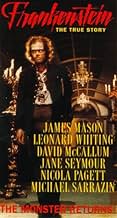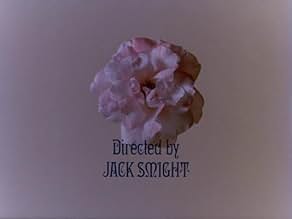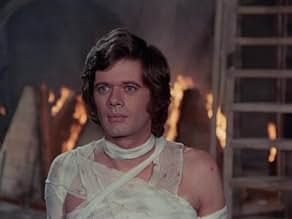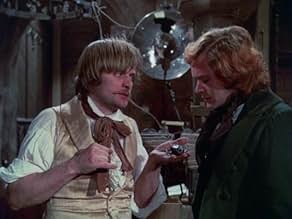Frankenstein, wie er wirklich war
Füge eine Handlung in deiner Sprache hinzuWhen the brilliant but unorthodox scientist Dr. Victor Frankenstein rejects the artificial man that he has created, the Creature escapes and later swears revenge.When the brilliant but unorthodox scientist Dr. Victor Frankenstein rejects the artificial man that he has created, the Creature escapes and later swears revenge.When the brilliant but unorthodox scientist Dr. Victor Frankenstein rejects the artificial man that he has created, the Creature escapes and later swears revenge.
- Regie
- Drehbuch
- Hauptbesetzung
- Auszeichnungen
- 1 Nominierung insgesamt
- Lady Fanshawe
- (as Clarissa Kaye)
Empfohlene Bewertungen
Anyway, watching it again last night with much more seasoned eyes, I was able to appreciate so many more aspects of this very well done film. While not a direct interpretation of the novel, it is certainly among the top three film versions of the story. It's not what you would call action packed but surprisingly, clocking in at around 3 hours, doesn't drag either, due to a tight script.
It would have benifited from more music throughout as it carries a very sparse score. Guess it wasn't in the budget.
In this release there was a very crucial scene which didn't match my memory, and I've come to find out that it had been edited. It was a somewhat gory scene but for crying out loud, it was on TV in '73! And we couldn't put it on the DVD now?? I don't get it. Other than those couple of points, it really is a somewhat forgotten classic.
Simply stated, the film has a highly disconcerting and surprisingly overt homo-erotic edge. Instead of the inevitable "mad doctor" typical of films, Victor Frankestein is a remarkably handsome young man in the form of actor Leonard Whiting, a performer best known as Romeo in the famous 1968 ROMEO AND JULIET. He is seduced into the experiment by the equally handsome but distinctly odd Henry Clerval (David McCallum)--and not only do the two actors play the relationship in a disquietingly touchy-feely way, Clerval takes exception to Victor's fiancée Elizabeth (Nicola Pagett) and she returns the favor, demanding that Victor choose between them.
Lest any one miss the implications, the creature is played by none other than Michael Sarrazin, and while many men may be described as handsome, Sarrazin is among the few who can be justly described as beautiful. He arises from the laboratory table barely decent in a few strategically placed bandages, and when his facial covering is pulled aside by the eager Dr. Frankenstein we are treated to a lingering image of glossy black hair, pale complexion, remarkably liquid eyes, and lips that would make Vogue model weep with envy. Dr. Frankenstein takes him to his own apartment, where he educates this child-like innocent and very generously allows the creature to sleep in his own bed.
But, as in all FRANKENSTEIN movies, the experiment goes awry, and when it does the same disconcerting homo-erotic overtones take yet another turn. Due to some unknown error in the creation process, the creature begins to deteriorate in appearance--and instead of continuing to treat him kindly, Frankenstein keeps the creature locked up, becomes verbally abusive to him, and no longer allows the creature to sleep in his bed, relegating him to a cramped mattress on the floor. At the same time, Frankenstein is approached by the mysterious Dr. Polidori (the legendary James Mason), an oily scientist with a flair for hypnosis who claims to know what went wrong.
Polidori insists that they abandon the creature and create a new one: a woman, and when this new creation emerges from an entirely different process she too is remarkably beautiful; indeed, she is none other than Jane Seymour. But whereas the original creature was a gentle creature who only learned violence from Frankenstein's hateful rejection, this new entity is strangely icy, almost snake-like from the very beginning--and the male creature, now both vicious and wildly jealous, will exact a horrific toll upon all concerned.
It is worth pointing out that the script for this version of FRANKENSTEIN was co-authored by Christopher Isherwood (1904-1986), one of the few openly gay writers of his era. Sexuality in general and homosexuality in particular forms a theme in many of Isherwood's works, so it would seem reasonable to assume that he was responsible for the homo-erotic elements of the film. Jack Smight's direction does not offer anything nearly so interesting as the script, but it is workman-like, and while the production values tend to be a shade too baroque for their own good one never lacks for something to look at on the screen.
The cast is also quite good. At the time, the film was looked upon as a "television event," and it drew a host of noted actors, including John Gielgud and Agnes Moorehead. No one would accuse Leonard Whiting of being a great screen talent, but he acquits himself very well; so too does David McCallum, Nicola Pagett, and the always memorable James Mason. But the real knock-out performances here are by Sarrazin and Seymour, who truly blow the lid off our ideas of what a FRANKENSTEIN movie should be--and when they square off the result is unsettling in a truly unexpected way. In terms of the DVD itself, the film quality is considerably better than the rare late-night showings I've occasionally seen on television, but I would not describe it as pristine, and I found I frequently had to bump up the volume on the soundtrack.
If you are looking for something with which to scare yourself silly, you might want to give this version FRANKENSTEIN a miss; although it has a few visceral moments, the jolts involved are largely psycho-sexual. But if you are open to the sexually subversive, which is particularly unexpected in a made-for-television film from 1973, you couldn't make a better choice. Recommended.
GFT, Amazon Reviewer
True Story owes little to previous movie versions, neither the mossy old 1930's and 'forties Universal Frankenstein series or Hammer's 1950's/'60's revivals, but is a completely fresh approach. The brilliant script by Isherwood and Bachardy is almost as literary as Mrs. Shelly novel, yet even more exciting and stimulating. True Story is a splendid production, probably one of the most handsomely turned out made-for-TV numbers of all time. Period (1797 and following) sets and costumes are exquisite. The cinematography is beautiful, belying its TV origins every step of the way. Unlike most TV movies of the time and practically all current theatrical movies, it disdains the shot-a-second montage method in favor of the mise-en-scene approach -- every scene starts with a precisely composed long shot, which gradually pans in to close-up. This classic style of cinematography complements the beautiful sets, enhances the melancholy mood, and displays the humanity of the characters better than montage. Here it is used brilliantly by director of photography Arthur Ibbetson and director Jack Smight.
Frankenstein: The True Story is expertly acted by Mason, Leonard Whiting (Victor), Nicole Padget (Elizabeth), Michael Sarrizan (Creature), Jane Seymour (female creature) and the rest of a fine cast. It is dramatically engaging, thoroughly engrossing for its entire three hours, intellectually stimulating, and gorgeously filmed. A delight from beginning to end. Even Old Hollywood would have been proud to have turned out such a complete motion picture.
P.S. -- Those who are interested in learning more about that early 19th century femme fa-tale and the origin of her famous monster story would do well to read Miranda Seymour's superbly researched, highly readable biography of Mary Shelly (Grove Press, NY, 2000).
Wusstest du schon
- WissenswertesThe character "Dr. Polidori" is not in Mary Shelley's novel, although he includes elements of Victor Frankenstein's mentors, Doctors Waldman and Krempe. He is primarily based on Dr. Septimius Pretorius from Frankensteins Braut (1935), but the name had to be changed because the Pretorius character is not in the public domain. He is named for Shelley's friend John William Polidori, who wrote a novella called "The Vampyre," which he began in the same weekend that she got the idea to write "Frankenstein". Polidori served as doctor for Lord Byron, who mockingly called him "Pollydolly", just like Clerval does in the film.
- PatzerWhen Polidori introduces Victor to the creature in his carriage, the interior point of view shot shows a Chinese servant closing the carriage door. A split second later, in a reverse angle shot from the exterior, the servant has vanished.
- Zitate
Dr. Henry Clerval: You're afraid. I was afraid at first. It's the way we've been brought up. We've been brought up to fear! To fear the punishment of the gods. But Prometheus defied them.
Dr. Victor Frankenstein: And they punished him!
Dr. Henry Clerval: He scorned their punishment. So has every other hero that's stolen secrets from nature to give to mankind.
- Alternative VersionenThe widely seen version features a prologue with James Mason visiting the supposed grave of Mary Shelley. However, test screenings showed a longer prologue, depicting Mary Shelley and her friends coming up with the Frankenstein story at a Swiss villa, similar to the opening of Frankensteins Braut (1935). This was cut and replaced by the simpler version after the test audiences were bored by it.
- VerbindungenFeatured in Der phantastische Film: Frankenstein, wie er wirklich war 1 (1980)
Top-Auswahl
Details
- Erscheinungsdatum
- Herkunftsländer
- Offizieller Standort
- Sprachen
- Auch bekannt als
- Frankenstein: The True Story
- Drehorte
- Produktionsfirma
- Weitere beteiligte Unternehmen bei IMDbPro anzeigen
- Laufzeit3 Stunden 5 Minuten
- Sound-Mix
Zu dieser Seite beitragen





































